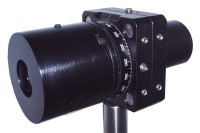High Power Attenuators /Optical Isolator Faraday Rotators / Quartz Retardation Plates
High Power Attenuator Using Glan Taylor Polarizer
This optical attenuator can be used at wavelengths between 0.35-2.0µm. Maximum continuous rating is 200W/cm2 and peak power handling is up to 500MW/cm2 for q-switched pulses. If the attenuator is used with plane polarized light the maximum transmission is 90% and with unpolarized light the maximum transmission is 40%. Details

Faraday Optical Isolator / Rotator – Type F0I 5
These are Faraday rotators, in which the plane of polarization of a laser beam is rotated through 45° as it passes through a high Verdet constant material, positioned in an axial magnetic field produced by permanent magnets.Some optical glasses (e.g. FS57 and special grades of glass
selected for their Verdet constant) may be used, but Leysop only uses the highest quality single crystal TGG (terbium gallium garnet). This offers the highest Verdet constant for the visible to near infrared region and provides high power handling with low optical distortion. Details

Broadband & Ultra Wide Band Faraday Optical Isolator / Rotator
Leysop’s broadband and ultra wide rotators / isolators are designed for use over the range of wavelengths covered typically by the Ti:Sapphire laser source, that is 700nm to 900nm fixed and 650 – 1100 nm tunable. Over this range, the isolation should remain greater than 30dB without any retuning being required. Details
for Ti:Sapphire
now available
Quartz Optical Rotator
Quartz rotators can be supplied to give 90° rotation or any angle between 0-90°. They are ordered as standard components with the same aperture and mount dimensions as retardation plates. Details
Low Order Quartz Retardation Plate
Leysop’s low order retardation plates use high optical damage threshold crystal quartz. They are orientated with the optic axis in the plane of the plate and light polarized at 45° to the quartz optic axis is resolved into two equal amplitude components that suffer a relative phase retardation due to their different propagating velocities. Details
